Paper Menu >>
Journal Menu >>
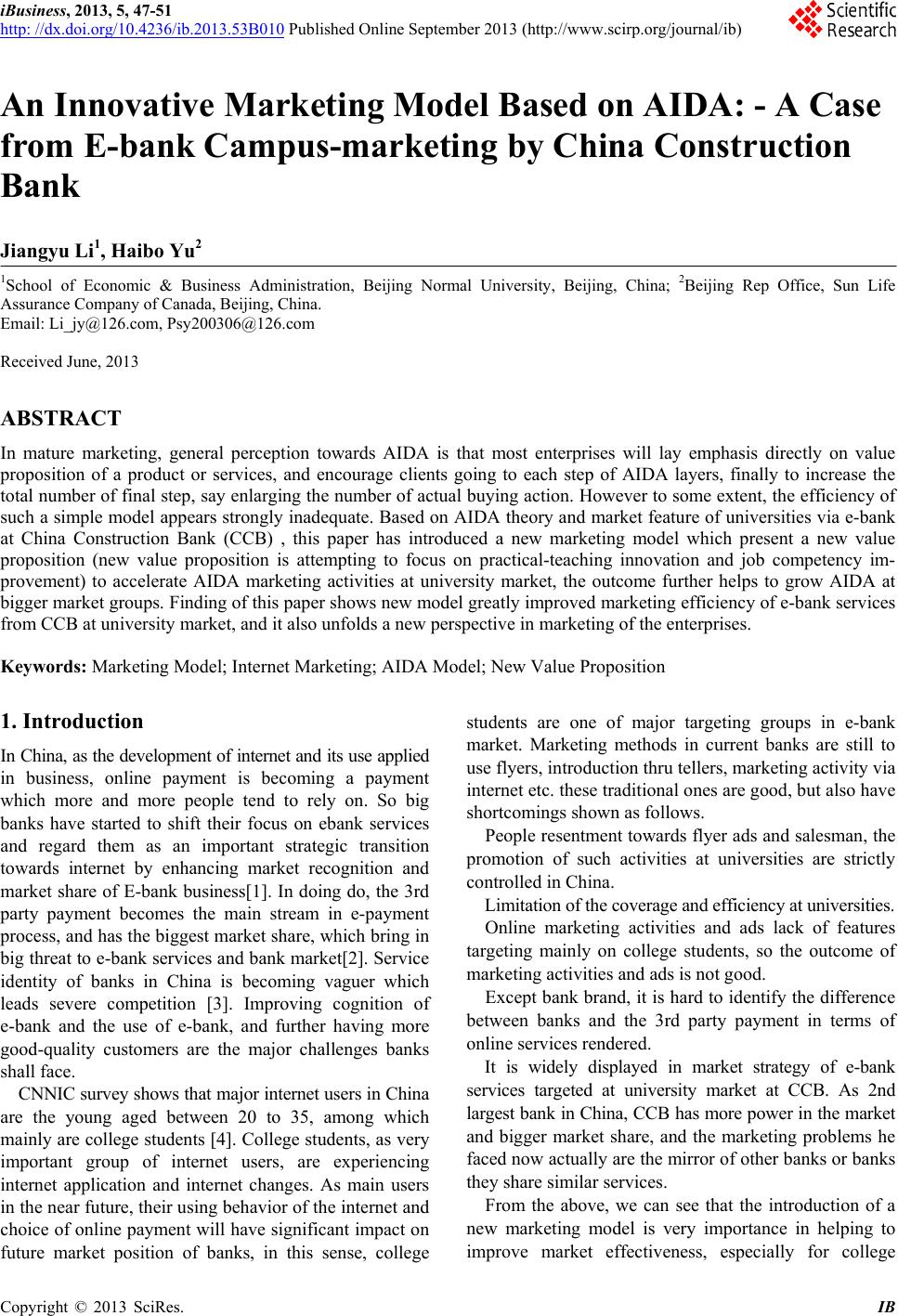 iBusiness, 2013, 5, 47-51 http: //dx.doi.org/10.4236/ib.201 3.53B010 Published Online September 2013 (http://www.scirp.org/journal/ib) 47 An Innovative Marketing Model Based on AIDA: - A Case from E-bank Campus-marketing by China Construction Bank Jiangyu Li1, Haibo Yu2 1School of Economic & Business Administration, Beijing Normal University, Beijing, China; 2Beijing Rep Office, Sun Life Assurance Company of Canada, Beijing, China. Email: Li_jy@126.com, Psy200306@126.com Received June, 2013 ABSTRACT In mature marketing, general perception towards AIDA is that most enterprises will lay emphasis directly on value proposition of a product or services, and encourage clients going to each step of AIDA layers, finally to increase the total number of final step, say enlarging the number of actual buying action. However to some extent, the efficiency of such a simple model appears strong ly inadequate. Based on AIDA theory and market feature of universities via e-bank at China Construction Bank (CCB) , this paper has introduced a new marketing model which present a new value proposition (new value proposition is attempting to focus on practical-teaching innovation and job competency im- provement) to accelerate AIDA marketing activities at university market, the outcome further helps to grow AIDA at bigger market groups. Finding of this paper shows new model greatly improved marketing efficiency of e-bank services from CCB at university market, and it also unfolds a new persp ective in marketing of the enterprises. Keywords: Marketing Model; Internet Marketing; AIDA Model; New Value Proposition 1. Introduction In China, as the deve lopment of in ternet and i ts use appli ed in business, online payment is becoming a payment which more and more people tend to rely on. So big banks have started to shift their focus on ebank services and regard them as an important strategic transition towards internet by enhancing market recognition and market share of E-bank business[1]. In doing do, the 3rd party payment becomes the main stream in e-payment process, and has the biggest market share, which bring in big threat to e-bank services and bank market[2]. Service identity of banks in China is becoming vaguer which leads severe competition [3]. Improving cognition of e-bank and the use of e-bank, and further having more good-quality customers are the major challenges banks shall face. CNNIC survey shows th at maj or internet u sers in China are the young aged between 20 to 35, among which mainly are college students [4]. Co llege students, as very important group of internet users, are experiencing internet application and internet changes. As main users in the near future, their using behavior of the in ternet and choice of online payment will have significant impact on future market position of banks, in this sense, college students are one of major targeting groups in e-bank market. Marketing methods in current banks are still to use flyers, introduction thru tellers, marketing activity via internet etc. these traditional ones are good, but also have shortcomings shown as follows. People resentment towards flyer ads and salesman, the promotion of such activities at universities are strictly controlled in China. Limitation of the coverage and efficiency at universities. Online marketing activities and ads lack of features targeting mainly on college students, so the outcome of marketing activities and ad s is not good. Except bank brand, it is hard to identify the difference between banks and the 3rd party payment in terms of online services rendered. It is widely displayed in market strategy of e-bank services targeted at university market at CCB. As 2nd largest bank in China, CCB has more power in the market and bigger market share, and the marketing problems he faced now actually are the mirror of other banks or banks they share similar services. From the above, we can see that the introduction of a new marketing model is very importance in helping to improve market effectiveness, especially for college Copyright © 2013 SciRes. IB 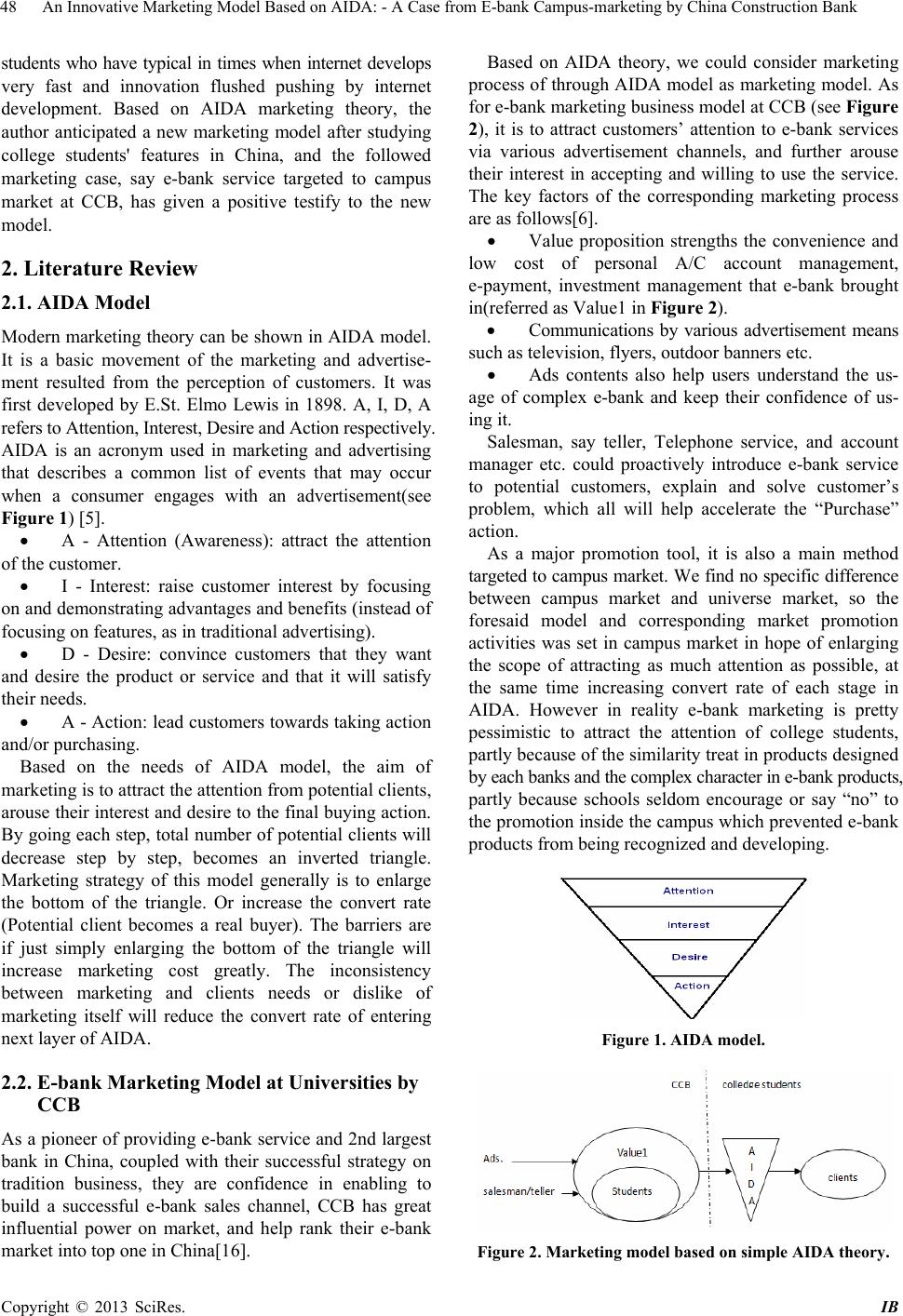 An Innovative Marketing Model Based on AIDA: - A Case from E-bank Campus-marketing by China Construction Bank 48 students who have typical in times when internet develops very fast and innovation flushed pushing by internet development. Based on AIDA marketing theory, the author anticipated a new marketing model after studying college students' features in China, and the followed marketing case, say e-bank service targeted to campus market at CCB, has given a positive testify to the new model. 2. Literature Review 2.1. AIDA Model Modern marketing theory can be shown in AIDA model. It is a basic movement of the marketing and advertise- ment resulted from the perception of customers. It was first developed by E.St. Elmo Lewis in 1898. A, I, D, A refers to Attention, Interest, Desire and Action respectively. AIDA is an acronym used in marketing and advertising that describes a common list of events that may occur when a consumer engages with an advertisement(see Figure 1) [5]. A - Attention (Awareness): attract the attention of the customer. I - Interest: raise customer interest by focusing on and demonstrating advantages and benefits (instead of focusing on features, as in traditio nal advertising). D - Desire: convince customers that they want and desire the product or service and that it will satisfy their needs. A - Action: lead customers towards taking action and/or purchasing. Based on the needs of AIDA model, the aim of marketing is to attract the attention from potential clients, arouse their interest and desire to the final buying action. By going each step, total number of potential clients will decrease step by step, becomes an inverted triangle. Marketing strategy of this model generally is to enlarge the bottom of the triangle. Or increase the convert rate (Potential client becomes a real buyer). The barriers are if just simply enlarging the bottom of the triangle will increase marketing cost greatly. The inconsistency between marketing and clients needs or dislike of marketing itself will reduce the convert rate of entering next layer of AIDA. 2.2. E-bank Marketing Model at Universities by CCB As a pioneer of providin g e-bank service and 2nd largest bank in China, coupled with their successful strategy on tradition business, they are confidence in enabling to build a successful e-bank sales channel, CCB has great influential power on market, and help rank their e-bank market into top one in China[16]. Based on AIDA theory, we could consider marketing process of through AIDA model as marketing model. As for e-bank marketing business model at CCB (see Figure 2), it is to attract customers’ attention to e-bank services via various advertisement channels, and further arouse their interest in accepting and willing to use the service. The key factors of the corresponding marketing process are as follows[6]. Value proposition strengths the convenience and low cost of personal A/C account management, e-payment, investment management that e-bank brought in(referred as Value1 in Figure 2). Communications by various advertisement means such as television , fl y ers, o ut d oo r banners etc. Ads contents also help users understand the us- age of complex e-bank and keep their confidence of us- ing it. Salesman, say teller, Telephone service, and account manager etc. could proactively introduce e-bank service to potential customers, explain and solve customer’s problem, which all will help accelerate the “Purchase” action. As a major promotion tool, it is also a main method targeted to campus market. We find no specific difference between campus market and universe market, so the foresaid model and corresponding market promotion activities was set in campus market in hope of enlarging the scope of attracting as much attention as possible, at the same time increasing convert rate of each stage in AIDA. However in reality e-bank marketing is pretty pessimistic to attract the attention of college students, partly because of the similarity treat in products designed by each banks and the complex character in e-bank products, partly because schools seldom encourage or say “no” to the promotion inside the campus which prevented e-bank products from being recognized and developing. Figure 1. AIDA model. Figure 2. Marketing model based on simple AIDA theory. Copyright © 2013 SciRes. IB 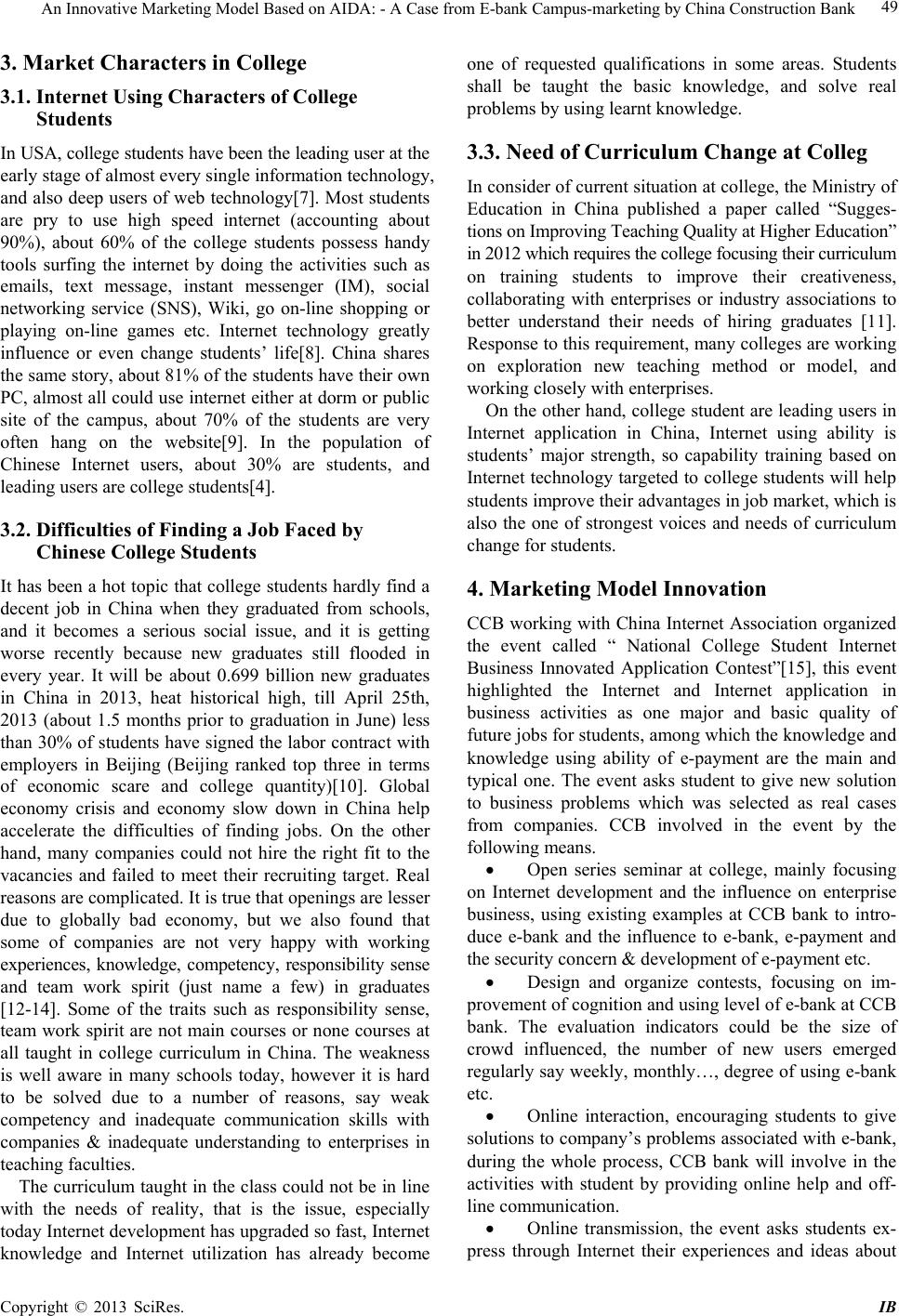 An Innovative Marketing Model Based on AIDA: - A Case from E-bank Campus-marketing by China Construction Bank 49 3. Market Characters in College 3.1. Internet Using Characters of College Students In USA, college students have been the leading user at the early stage of almost every single information technology, and also deep users of web technology[7]. Most students are pry to use high speed internet (accounting about 90%), about 60% of the college students possess handy tools surfing the internet by doing the activities such as emails, text message, instant messenger (IM), social networking service (SNS), Wiki, go on-line shopping or playing on-line games etc. Internet technology greatly influence or even change students’ life[8]. China shares the same story, about 81% of the students have their own PC, almost all could use internet either at dorm or public site of the campus, about 70% of the students are very often hang on the website[9]. In the population of Chinese Internet users, about 30% are students, and leading users are college students[4]. 3.2. Difficulties of Finding a Job Faced by Chinese College Students It has been a hot topic that college students hardly find a decent job in China when they graduated from schools, and it becomes a serious social issue, and it is getting worse recently because new graduates still flooded in every year. It will be about 0.699 billion new graduates in China in 2013, heat historical high, till April 25th, 2013 (about 1.5 months prior to graduation in June) less than 30% of students have signed the labor contract with employers in Beijing (Beijing ranked top three in terms of economic scare and college quantity)[10]. Global economy crisis and economy slow down in China help accelerate the difficulties of finding jobs. On the other hand, many companies could not hire the right fit to the vacancies and failed to meet their recruiting target. Real reasons are complicated. It is true that openings are lesser due to globally bad economy, but we also found that some of companies are not very happy with working experiences, knowledge, competency, responsibility sense and team work spirit (just name a few) in graduates [12-14]. Some of the traits such as responsibility sense, team work spirit are not main courses or none courses at all taught in college curriculum in China. The weakness is well aware in many schools today, however it is hard to be solved due to a number of reasons, say weak competency and inadequate communication skills with companies & inadequate understanding to enterprises in teaching faculties. The curriculum taught in the class could not be in line with the needs of reality, that is the issue, especially today Internet development has upgraded so fast, Internet knowledge and Internet utilization has already become one of requested qualifications in some areas. Students shall be taught the basic knowledge, and solve real problems by using learnt knowledge. 3.3. Need of Curriculum Change at Colleg In consider of current situation at college, the Ministry of Education in China published a paper called “Sugges- tions on Improving Teaching Qual ity at Higher Education” in 2012 which requires the college focusing their curriculum on training students to improve their creativeness, collaborating with enterprises or industry associations to better understand their needs of hiring graduates [11]. Response to this requirement, many colleges are working on exploration new teaching method or model, and working closely with enterprises. On the other hand, college student are leading users in Internet application in China, Internet using ability is students’ major strength, so capability training based on Internet technology targeted to college students will h elp students improve their advantages in job market, which is also the one of strongest voices and needs of curriculum change for students. 4. Marketing Model Innovation CCB working with China In ternet Association organized the event called “ National College Student Internet Business Innovated Application Contest”[15], this event highlighted the Internet and Internet application in business activities as one major and basic quality of future jobs for students, among which the knowledge and knowledge using ability of e-payment are the main and typical one. The event asks student to give new solution to business problems which was selected as real cases from companies. CCB involved in the event by the following means. Open series seminar at college, mainly focusing on Internet development and the influence on enterprise business, using existing examples at CCB bank to intro- duce e-bank and the influence to e-bank, e-payment and the security concern & development of e-payment etc. Design and organize contests, focusing on im- provement of cognition and using level of e-bank at CCB bank. The evaluation indicators could be the size of crowd influenced, the number of new users emerged regularly say weekly, monthly…, degr ee of using e-bank etc. Online interaction, encouraging students to give solutions to company’s problems associated with e-bank, during the whole process, CCB bank will involve in the activities with student by providing online help and off- line communication. Online transmission, the event asks students ex- press through Internet their experiences and ideas about Copyright © 2013 SciRes. IB 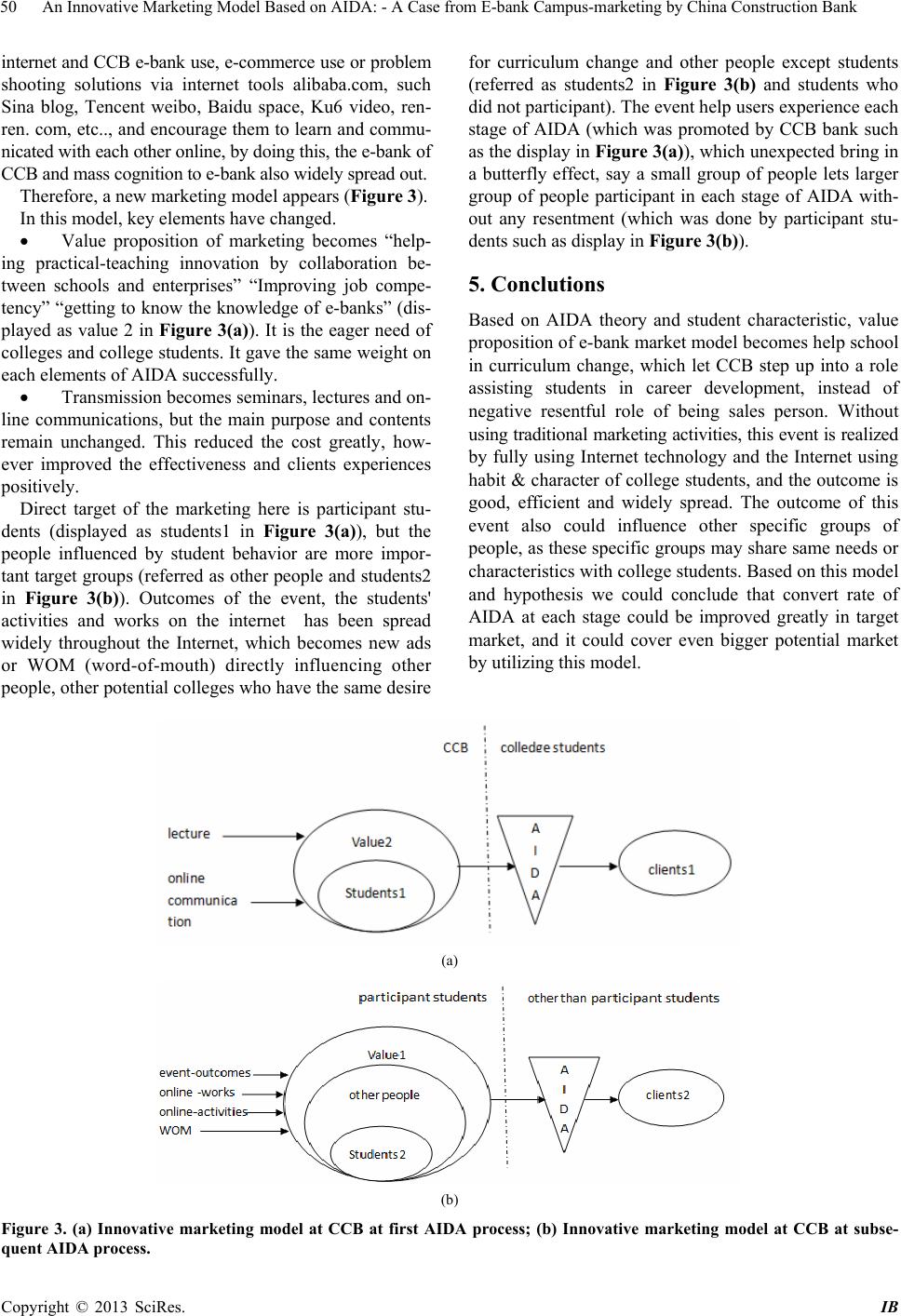 An Innovative Marketing Model Based on AIDA: - A Case from E-bank Campus-marketing by China Construction Bank Copyright © 2013 SciRes. IB 50 internet and CCB e-bank use, e-commerce use or problem shooting solutions via internet tools alibaba.com, such Sina blog, Tencent weibo, Baidu space, Ku6 video, ren- ren. com, etc.., and encourage them to learn and commu- nicated with each other online, by doing this, the e-bank of CCB and mass cognition to e-bank also widely spread out. Therefore, a new marketing model appears (Figure 3). In this model, key elements have changed. Value proposition of marketing becomes “help- ing practical-teaching innovation by collaboration be- tween schools and enterprises” “Improving job compe- tency” “getting to know the knowledge of e-banks” (dis- played as value 2 in Figure 3(a)). It is the eager need of colleges and college students. It gave the same weight on each elements of AIDA successfully. Transmission becomes seminars, lectures and on- line communications, but the main purpose and contents remain unchanged. This reduced the cost greatly, how- ever improved the effectiveness and clients experiences positively. Direct target of the marketing here is participant stu- dents (displayed as students1 in Figure 3(a)), but the people influenced by student behavior are more impor- tant target groups (r eferred as other people and students2 in Figure 3(b)). Outcomes of the event, the students' activities and works on the internet has been spread widely throughout the Internet, which becomes new ads or WOM (word-of-mouth) directly influencing other people, other potential co lleges who have the same desire for curriculum change and other people except students (referred as students2 in Figure 3(b) and students who did not participant). The event help users experience each stage of AIDA (which was promoted by CCB bank such as the display in Figure 3(a)), which unexpected bring in a butterfly effect, say a small group of people lets larger group of people participant in each stage of AIDA with- out any resentment (which was done by participant stu- dents such as display in Figure 3(b)). 5. Conclutions Based on AIDA theory and student characteristic, value proposition of e-bank market model beco mes help school in curriculum change, which let CCB step up into a role assisting students in career development, instead of negative resentful role of being sales person. Without using traditio nal marketing act ivities, this even t is realized by fully using Internet technology and the Internet using habit & character of college students, and the outcome is good, efficient and widely spread. The outcome of this event also could influence other specific groups of people, as these specif ic groups may share same needs or characteristics with college students. Based on this model and hypothesis we could conclude that convert rate of AIDA at each stage could be improved greatly in target market, and it could cover even bigger potential market by utilizing this model. (a) (b) Figure 3. (a) Innovative marketing model at CCB at first AIDA process; (b) Innovative marketing model at CCB at subse- quent AIDA process. 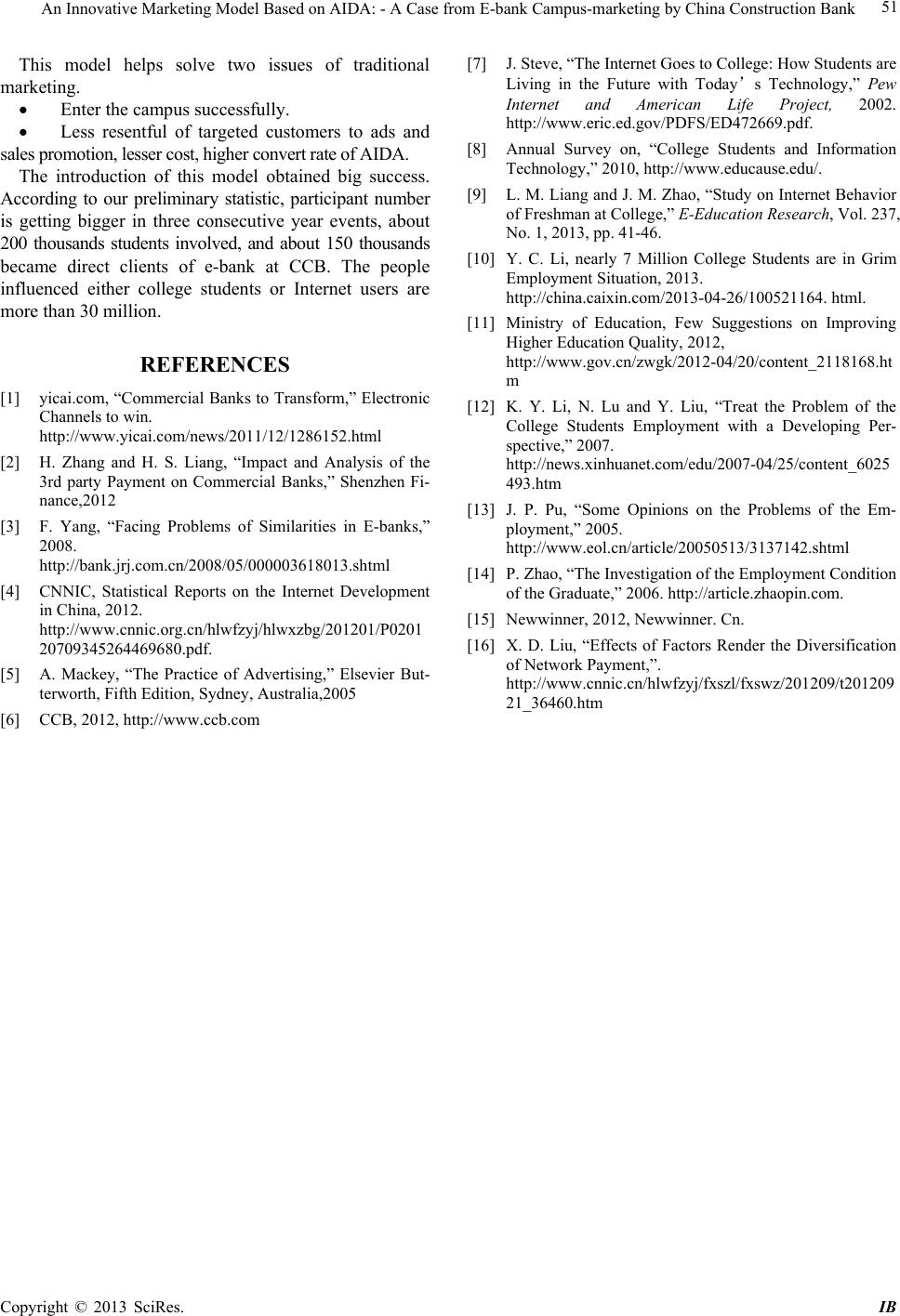 An Innovative Marketing Model Based on AIDA: - A Case from E-bank Campus-marketing by China Construction Bank 51 This model helps solve two issues of traditional marketing. Enter the campus successfully. Less resentful of targeted customers to ads and sales promotion, lesser cost, higher convert rate of AIDA. The introduction of this model obtained big success. According to our preliminary statistic, participant number is getting bigger in three consecutive year events, about 200 thousands students involved, and about 150 thousands became direct clients of e-bank at CCB. The people influenced either college students or Internet users are more than 30 million. REFERENCES [1] yicai.com, “Commercial Banks to Transform,” Electronic Channels to win. http://www.yicai.com/news/2011/12/1286152.html [2] H. Zhang and H. S. Liang, “Impact and Analysis of the 3rd party Payment on Commercial Banks,” Shenzhen Fi- nance,2012 [3] F. Yang, “Facing Problems of Similarities in E-banks,” 2008. http://bank.jrj.com.cn/2008/05/000003618013.shtml [4] CNNIC, Statistical Reports on the Internet Development in China, 2012. http://www.cnnic.org.cn/hlwfzyj/hlwxzbg/201201/P0201 20709345264469680.pdf. [5] A. Mackey, “The Practice of Advertising,” Elsevier But- terworth, Fifth Edition, Sydney, Australia,2005 [6] CCB, 2012, http://www.ccb.com [7] J. Steve, “The Internet Goes to College: How Students are Living in the Future with Today’s Technology,” Pew Internet and American Life Project, 2002. http://www.eric.ed.gov/PDFS/ED472669.pdf. [8] Annual Survey on, “College Students and Information Technology,” 2010, http://www.educause.edu/. [9] L. M. Liang and J. M. Zha o, “Study on Internet Behavior of Freshman at College,” E-Education Research, Vol. 237, No. 1, 2013, pp. 41-46. [10] Y. C. Li, nearly 7 Million College Students are in Grim Employment Situation, 2013. http://china.caixin.com/2013-04-26/100521164. html. [11] Ministry of Education, Few Suggestions on Improving Higher Education Quality, 2012, http://www.gov.cn/zwgk/2012-04/20/content_2118168.ht m [12] K. Y. Li, N. Lu and Y. Liu, “Treat the Problem of the College Students Employment with a Developing Per- spective,” 2007. http://news.xinhuanet.com/edu/2007-04/25/content_6025 493.htm [13] J. P. Pu, “Some Opinions on the Problems of the Em- ployment,” 2005. http://www.eol.cn/article/20050513/3137142.shtml [14] P. Zhao, “The Investigation of the Employment Condition of the Graduate,” 2006. http://article.zhaopin.com. [15] Newwinner, 2012, Newwinner. Cn. [16] X. D. Liu, “Effects of Factors Render the Diversification of Network Payment,”. http://www.cnnic.cn/hlwfzyj/fxszl/fxswz/201209/t201209 21_36460.htm Copyright © 2013 SciRes. IB |

